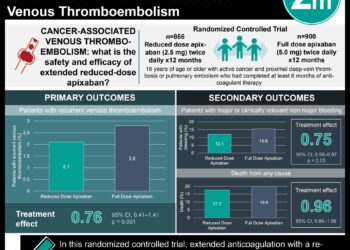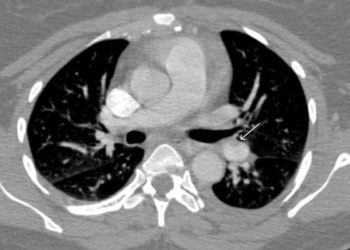Venous thromboembolism rates in hospitalized children continue to rise
1. In a large retrospective study, rates of venous thromboembolism (VTE) in pediatric patients increased from 46 to 106 per 10,000 hospital admissions between 2008 and 2019.
2. 78% of patients with a VTE admission had chronic complex medical conditions compared to 27% of patients without a VTE admission.
Evidence Rating Level: 2 (Good)
Study Rundown: Venous thromboembolism (VTE), including deep vein thrombosis (DVT) and pulmonary embolism (PE), is a significant cause of morbidity in children and adults alike. Hospitalized patients are at particularly high risk due to immobilization in addition to underlying disease states. This large, multicenter study aimed to quantify changes in VTE rates in hospitalized children between 2008 and 2019, replicating the methods of a previous study. Between 2001 and 2007, VTE rates had increased from 38 to 53 in 10,000. In the current study, almost 40,000 pediatric patients were diagnosed with VTE during more than 52,000 admissions. The rate of VTE increased from 46 cases per 10,000 admissions in 2008 to 106 per 10,000 in 2019, representing a 130% increase. The largest increases were in the adolescent age group, with 31% of VTE patients between the ages of 13 and 17, and in infants younger than 1 year. 78% of VTE patients had an underlying chronic complex condition, with a median of 3 conditions, compared to 27% of patients without VTE. 35% of VTE patients were dependent on technology such as gastrostomy or tracheostomy tubes or pacemakers. Due to limitations of the data, it is unclear what proportion of patients were initially admitted for VTE rather than having a VTE in the hospital. It is also unclear how much of the greatly increased VTE rate is due to higher rates of detection compared to a true increase in VTE. Though these questions and the risk factors for hospital VTE require further study, this study shows the worsening of a clear and urgent problem in pediatric hospital care. As more highly complex patients are cared for in pediatric hospitals, including patients with central venous catheters, protocols for VTE prophylaxis must be re-examined and updated.
Click to read the study in Pediatrics
Relevant Reading: Prevention of hospital-acquired venous thromboembolism in children: A review of published guidelines
In-Depth [retrospective cohort]: Retrospective data were drawn from the Pediatric Health Information System database, which represents 49 hospitals. ICD codes were used to identify all admissions with a DVT or PE recorded. Children from birth to 18 years old were included. The p-value was <0.0001 for the 130% increase in VTE events between 2008 and 2019 and for each age group. 35.4% of VTEs were upper extremity DVT, 28.4% lower extremity, and 9.1% PE. Compared to admissions without VTE, VTE admissions were longer, with a median length of stay of 13 days compared to 3 days and patients older, with a median age of 5.2 years compared to 3.8 years. VTE admissions were less likely to include an emergency department visit and more likely to include surgery, PICU admission, or NICU admission than admissions without a VTE. Enoxaparin was the most commonly prescribed therapy for VTE. Direct oral anticoagulants were used during 3% of admissions in 2019.
Image: PD
©2022 2 Minute Medicine, Inc. All rights reserved. No works may be reproduced without expressed written consent from 2 Minute Medicine, Inc. Inquire about licensing here. No article should be construed as medical advice and is not intended as such by the authors or by 2 Minute Medicine, Inc.







